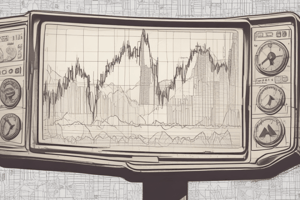Podcast
Questions and Answers
What is a characteristic of the second top in a double top pattern?
What is a characteristic of the second top in a double top pattern?
- No volume at all
- The same volume as the first top
- Distinctly less volume than the first top (correct)
- Higher volume than the first top
What does the sideways trend in a market cycle typically represent?
What does the sideways trend in a market cycle typically represent?
- A sudden reversal in the market
- A complete absence of market activity
- A transitional or horizontal phase (correct)
- A rapid acceleration of the trend
What typically occurs when a stock price is in an up trend?
What typically occurs when a stock price is in an up trend?
- It forms a double bottom
- It forms a double top (correct)
- It forms a gap
- It forms a head and shoulders pattern
What is the primary purpose of price patterns in financial markets?
What is the primary purpose of price patterns in financial markets?
What is the neckline in a head and shoulders pattern?
What is the neckline in a head and shoulders pattern?
What is the characteristic of a highly emotional market, as depicted in Figure 8.2?
What is the characteristic of a highly emotional market, as depicted in Figure 8.2?
What can be said about the volume of the second bottom in a double bottom pattern?
What can be said about the volume of the second bottom in a double bottom pattern?
What is the general direction of the price movement after a double top or double bottom pattern forms?
What is the general direction of the price movement after a double top or double bottom pattern forms?
What is the significance of the line BB in Figure 8.3?
What is the significance of the line BB in Figure 8.3?
What is a characteristic of the breakout in a double bottom pattern?
What is a characteristic of the breakout in a double bottom pattern?
What is the term used to describe the transitional or horizontal phase separating rising and falling price trends?
What is the term used to describe the transitional or horizontal phase separating rising and falling price trends?
What does the transition from a rising to a falling trend often resemble, in terms of its speed and momentum?
What does the transition from a rising to a falling trend often resemble, in terms of its speed and momentum?
What is the term used to describe the rectangle in Figure 8.5, marking the turning point between the bull and bear phases?
What is the term used to describe the rectangle in Figure 8.5, marking the turning point between the bull and bear phases?
What type of pattern is formed when the price hits a resistance level, then breaks through the first resistance level and hits a higher resistance level, and then hits the first resistance level again?
What type of pattern is formed when the price hits a resistance level, then breaks through the first resistance level and hits a higher resistance level, and then hits the first resistance level again?
What is the characteristic of volume during the formation of the left shoulder in a head-and-shoulders pattern?
What is the characteristic of volume during the formation of the left shoulder in a head-and-shoulders pattern?
What is the term used to describe the pattern at market tops, where the security is distributed from strong, informed participants to weak, uninformed ones?
What is the term used to describe the pattern at market tops, where the security is distributed from strong, informed participants to weak, uninformed ones?
What is the term used to describe the pattern at market bottoms, where the security passes from weak, uninformed participants to strong, informed ones?
What is the term used to describe the pattern at market bottoms, where the security passes from weak, uninformed participants to strong, informed ones?
What is the significance of the price pushing through line AA in Figure 8.6?
What is the significance of the price pushing through line AA in Figure 8.6?
Flashcards are hidden until you start studying




